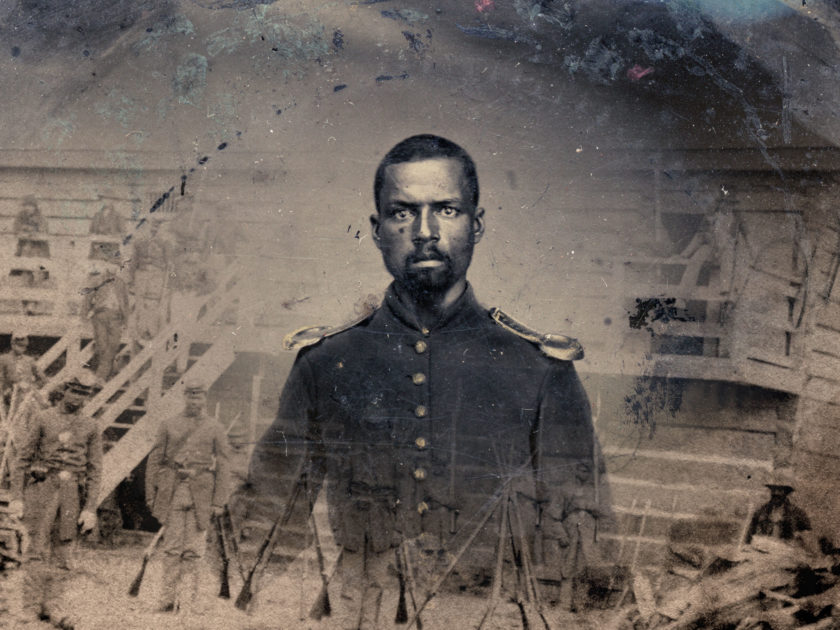No single group experienced such a dramatic change in fortunes during the Civil War than men of color. In 1861, the vast majority were held in bondage. Those who gained their freedom, whether legally or as runaways and refugees, were not allowed to serve in the military. By 1865, 180,000 black men wore blue and a small number served as commissioned officers. Not all became soldiers—some worked in service to Union officers or toiled as laborers. In the middle of this transformation stands the Emancipation Proclamation, which charted a course to universal equality. The remarkable rise to freedom in the war was followed by a steep decline during and after reconstruction, and the struggle for equality that continues today.

This trooper stands at attention with a saber placed against his shoulder. He wears a chasseur cap and a shell jacket to which is attached his corporal’s stripes in an unusually low position. His enlisted man’s cavalry saber appears to be either a Model 1840 or 1860. He likely served in one of the six cavalry regiments of U.S. Colored Troops organized during the Civil War, or in the 5th Massachusetts Cavalry, a regiment of free persons of African descent that formed in late 1863 and early 1864.
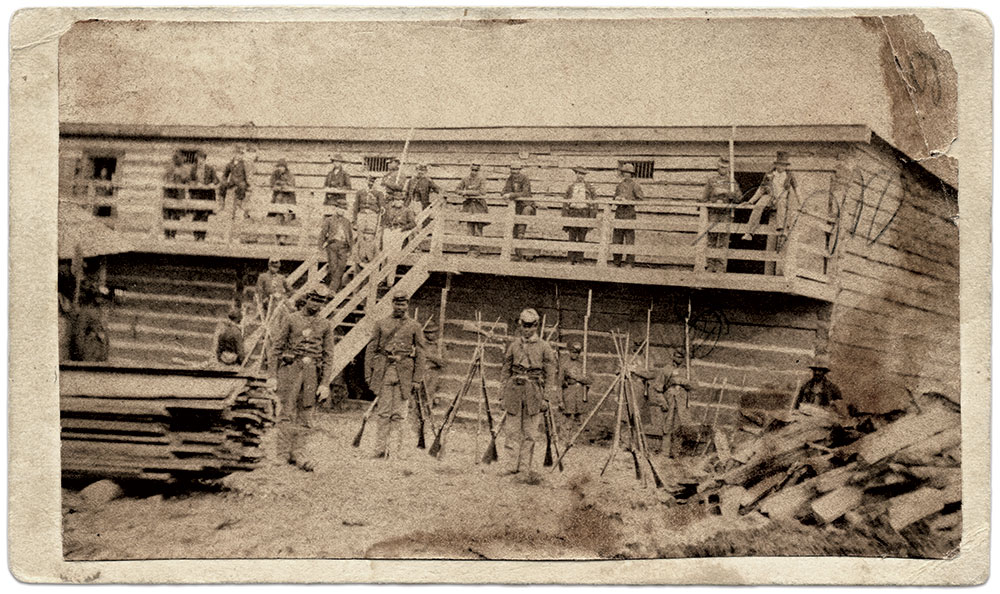
Non-commissioned officers and enlisted men stand with stacked muskets outside a log guardhouse or other outbuilding. The soldier in the middle is the ranking sergeant, and to his right is a corporal. Arranged on the staircase and upper deck are company officers, more enlisted men and civilians.
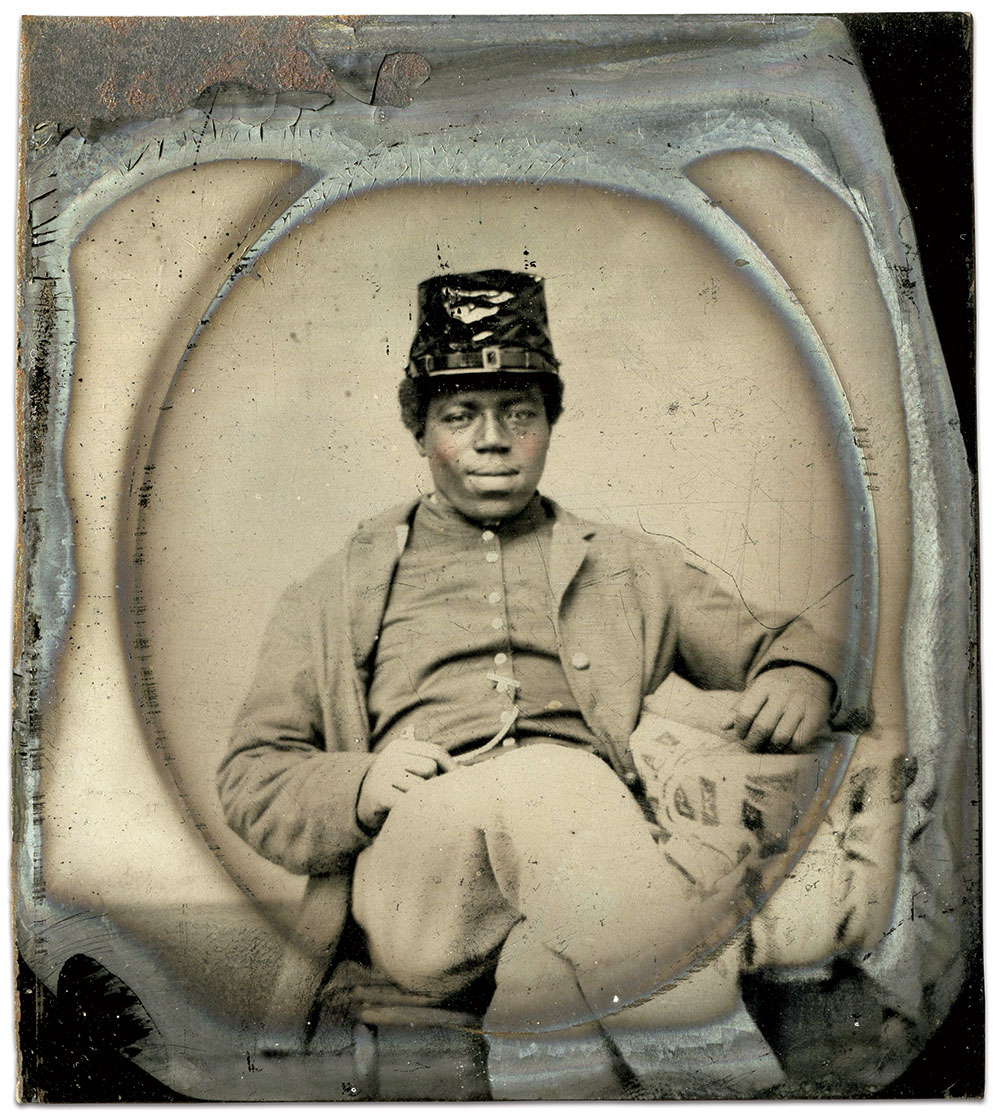
James T. Cummings of the 24th U.S. Colored Infantry participated in a little-known experimental program launched by the U.S. War Department during the waning months of the war. He was among a small number of “representative recruits” paid to serve by public-spirited men and women across the North. Such recruit sponsors included Abraham Lincoln and Henry Wadsworth Longfellow.
War Department officials hoped the program would avoid the need for another draft. But it raised only 1,292 recruits. Cummings, a 26-year old Pennsylvania bricklayer, collected a whopping $650. He completed his training and reported for duty to Washington in May 1865. By this time the war had ended, and both the program and draft became moot. Cummings mustered out with his comrades in October 1865, and returned home, where he lived until 1898.

Husband and wife? Brother and sister? Though the relationship of this sergeant and woman is not known, the effort with which her portrait was affixed to the velvet lining and the wear and tear to the case suggests this was a prized possession.
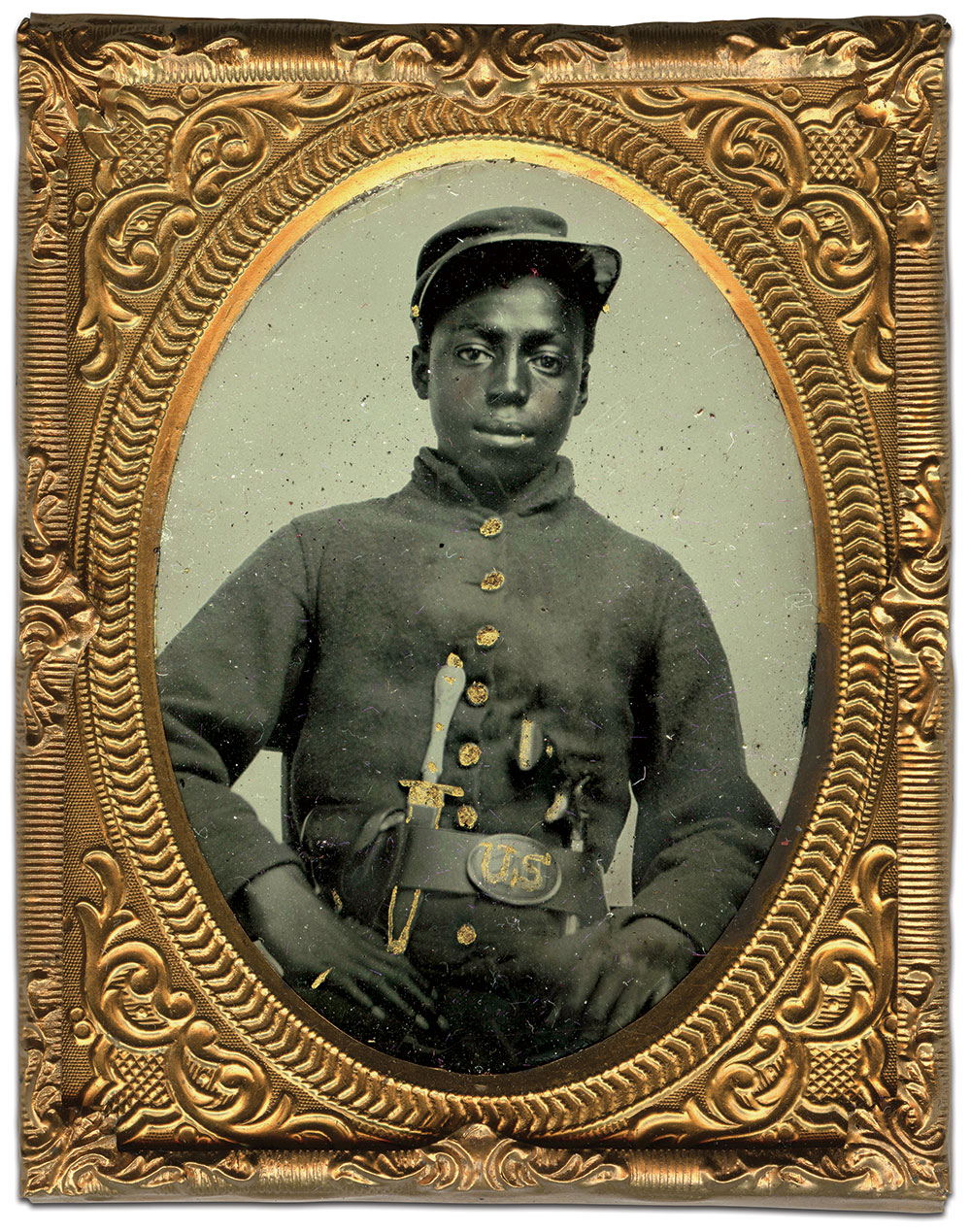
A young enlisted soldier is ready for action with a knife and Colt Root Revolver tucked into his waist belt, to which is attached a cap box.

A free farmer born in Sturbridge, Mass., 19-year-old George Samuel White enlisted in the 54th Massachusetts Infantry in the summer of 1864. He was not assigned to a company due to the large number of recruits for the regiment. Officials transferred him to the 55th Massachusetts Infantry, which was in need of men to replenish its ranks, and he joined Company I as a private.
White faced his first combat at Honey Hill, S.C., on Nov. 30, 1864. During the battle, he suffered a shell wound in his left calf—one of about 142 casualties, the highest number in any single action during the regiment’s service. He eventually recovered, rejoined his comrades and mustered out in August 1865. He lived until 1923, dying in Bronx, N.Y.

Wearing two rings on his pinky finger, a clean-shaven young man dressed in a standard 9-button frock coat and non-regulation pants sits for his portrait. The patriotic-themed brass mat reminds us of the 1776 Revolution and the war to preserve the Union in 1861, which would end in a measure of freedom for the sitter and his race.

The disparate items of military clothing and accouterments worn by this young man, left, suggest he served a Union officer. His light-colored shell jacket, vest and well-tailored pants with lining visible above the cuffs may be hand-me-downs from the Northerner who employed him. The waist belt plate embossed with a wreath may have originated with a pre-war militia company. A standard-issue Model 1859 canteen and cap with waterproof cover completes the picture.

On April 3, 1865, Pvt. William Wright and his comrades in the 114th U.S. Colored Infantry marched into Richmond, Va., just hours after the Confederate military and government abandoned the capital. For Wright, of African and German descent, the event marked the culmination of a journey that began nine months earlier when he enlisted in the Union army. He did so with the consent of his master, John Russell, a pro-Union slave owner who owned a plantation outside Frankfort, Ky.
Wright mustered out of the army with his comrades in May 1867. He returned home to his wife and children in Kentucky, but was forced to flee in 1871 after being repeatedly harassed by bands of white marauders. According to one account, Wright left because “he had fought too hard for his freedom and rights in the Civil War to have them taken from him.”
The family settled in Iowa, where his wife died in 1872. Wright remarried in 1874, started another family, and lived until 1901.
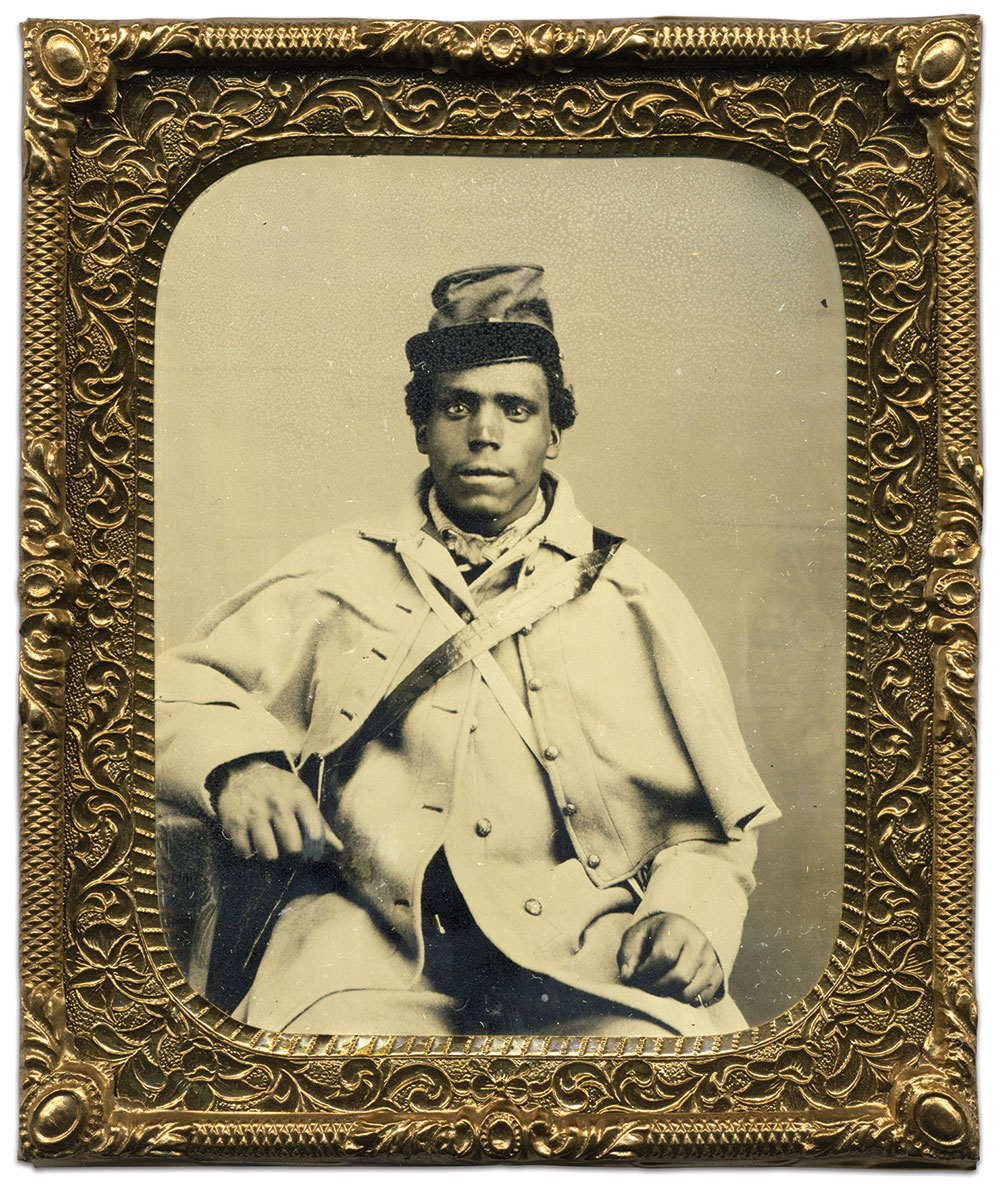
This federal soldier is protected from the cold weather by a greatcoat. He carries a leather haversack on one side and a canteen with a cloth strap on the other.
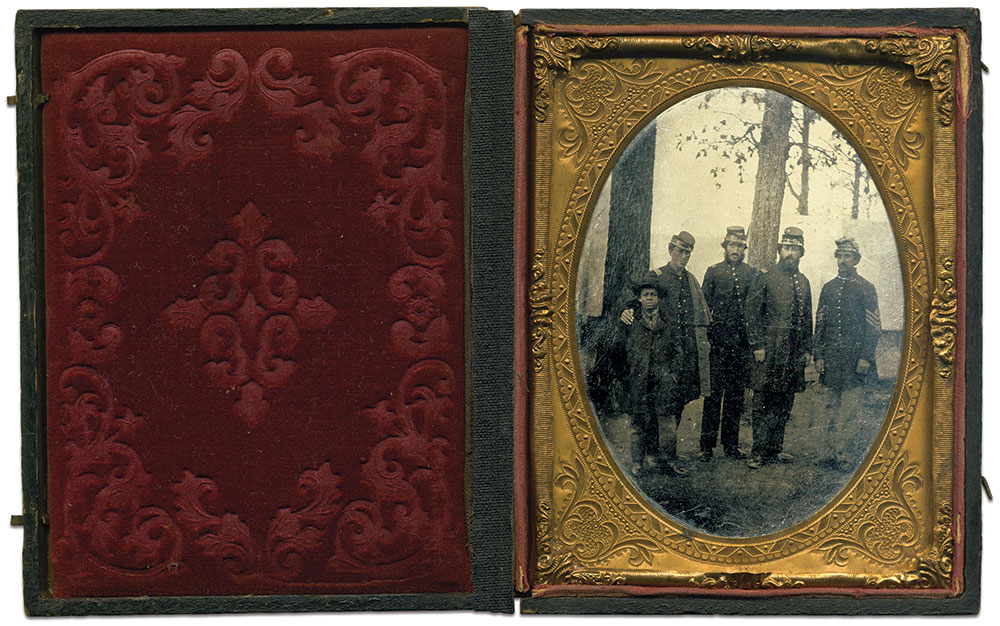
A second lieutenant rests a hand on the shoulder of a boy dressed in a military blouse and an overcoat. Two other officers and a first sergeant are also present. The leafless trees and tent suggest a camp scene in Confederate territory. If so, the boy is possibly one of the uncounted slave children who ran away from a nearby plantation to seek a better life with the invading Union armies.

According to an inscription on the back of this albumen, below, James Montgomery was a slave who practiced the culinary arts for a wealthy Southern family. He ran away to follow the Northern Army and landed in the camp of the 93rd New York Infantry, where he became “The Celebrated Cook” of Company A. The 93rd served as Headquarters Guard of the Army of the Potomac from May 1862 to April 1864, spanning the tenures of four commanding generals, from George B. McClellan to George G. Meade.
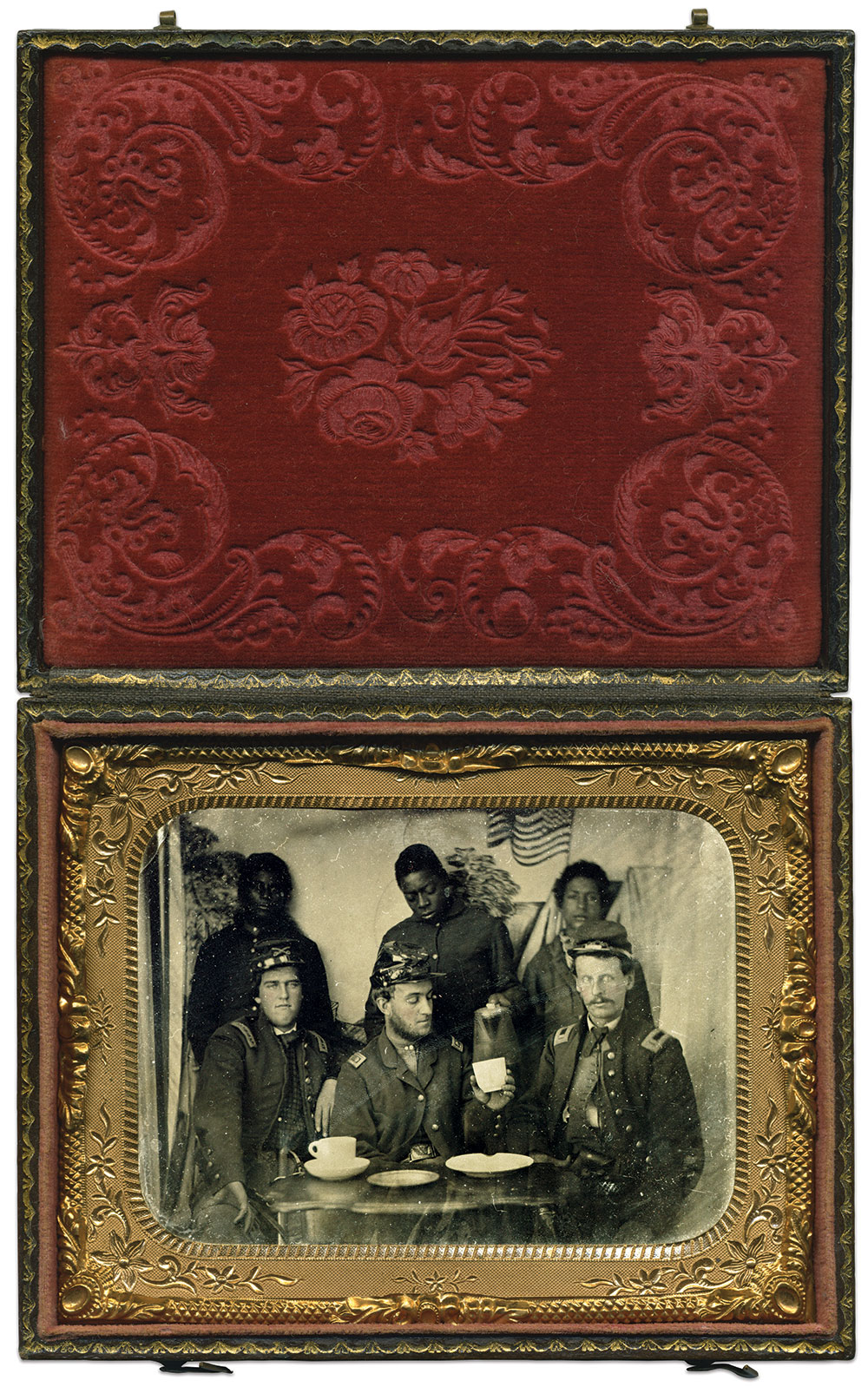
The hard lines drawn by race in American culture are disturbingly clear in this portrait of a trio of Union cavalry officers, who pose with a coffee service and servants in military coats.
This tintype is in the collection of Rick Brown, who observes, “The servants to the left and right do not give off the calm facial expression that their white counterparts do and seem to be placed there almost as if they are directly there to serve each officer. The young man in the middle of the image is focusing on pouring the coffee, but his manner suggests to me an aura of embarrassment or sorrow—he doesn’t want to be in this photograph. The white officer is focusing on the cup with a satisfied expression that suggests entitlement and enjoyment as the servant reluctantly prepares to pour out his emotions in the form of coffee.”
Brown notes the presence of the Stars and Stripes and the pristine eagle on the belt buckle of the officer in the center, “In a photograph where racial division is so evident, it strikes me that the eagle is glistening, polished without a single flaw, which is ironic considering the great social inequalities that existed. The flag blows from the less common right to left, as if the unsettled winds of war are blowing in the wrong direction.”
Brown adds, “This image also reminds us that racism was just as prevalent in the North as it was in the South.”
SPREAD THE WORD: We encourage you to share this story on social media and elsewhere to educate and raise awareness. If you wish to use any image on this page for another purpose, please request permission.
LEARN MORE about Military Images, America’s only magazine dedicated to showcasing, interpreting and preserving Civil War portrait photography.
VISIT OUR STORE to subscribe, renew a subscription, and more.

